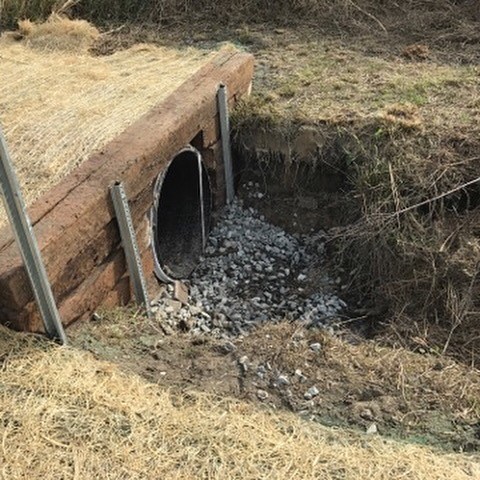Culvert Setup Facilitated: Step-by-Step Overview for Success
Mounting culverts might appear like a simple task, yet making sure an effective result calls for cautious planning and implementation. From selecting the proper culvert size to incorporating appropriate drain measures, each action in the setup procedure plays an essential role in the functionality and long life of the culvert system. By complying with a methodical method and taking notice of crucial details, the installment can continue efficiently, decreasing potential issues down the line. Remain tuned to uncover the essential steps and factors to consider that can make culvert setup a seamless and successful endeavor.
Choosing the Right Culvert Dimension
Selecting the ideal culvert size is important for making certain reliable water flow and architectural integrity in culvert setup tasks - Pad Construction. The dimension of the culvert straight impacts the flow ability of water through the framework. A culvert that is too little can cause flooding and overflow, while one that is as well large may cause lowered water rate, possibly creating debris build-up and obstructions
To identify the best culvert dimension, aspects such as the watershed area, peak circulation prices, and hydraulic effectiveness requirement to be meticulously considered. Estimations based upon these specifications help in picking a dimension that can adequately deal with the expected water quantity while lessening the risk of clogs and structural failing.
It is necessary to consult design guidelines and criteria to make sure that the chosen culvert dimension meets the project needs and regional regulations (Pad Construction). By picking the ideal culvert dimension, task supervisors can enhance water circulation, stop possible problems, and boost the overall effectiveness and durability of the culvert installation
Preparing the Setup Site
Effective culvert installation requires meticulous prep work of the setup website to guarantee optimum structural assistance and performance. Before starting the installation procedure, it is essential to get rid of the site of any type of debris, greenery, or blockages that could hinder the culvert's positioning. Ensuring a degree foundation is important for the correct alignment and stability of the culvert. This might entail grading the website to develop a smooth, also surface that can appropriately support the weight of the culvert and any type of awaited lots. In addition, appropriate compaction of the dirt beneath the culvert is required to avoid settling or moving with time.
Moreover, it is very important to think about aspects such as soil composition, groundwater degrees, and environmental influences when preparing the installment website. Carrying out an extensive site evaluation can aid recognize any possible difficulties or threats that might impact the culvert's performance. By taking the time to prepare the installation website properly, you can help assure an effective culvert setup that fulfills architectural demands and ensures lasting performance.
Placing the Culvert Appropriately

The quality at which the culvert is placed is important for maintaining an appropriate incline for water flow. A gradual incline helps prevent pooling and advertises reliable drainage. Furthermore, the culvert needs to be oriented correctly to guarantee that the inlet and outlet are in the appropriate areas. This alignment is important for the culvert to work effectively in taking care of water circulation.
Backfilling and Compacting the Soil
Proper backfilling and compaction of the soil around the culvert is necessary to make sure security and avoid possible concerns in the future. As soon as the culvert is appropriately positioned, the following crucial action is to backfill the location around it with suitable material. The backfill material should be free from rocks, particles, and raw material to prevent damage to the culvert. It is recommended to use granular material such as sand or crushed rock for backfilling, as it gives great drainage and compaction residential or commercial properties.
After putting the backfill material, it is important to portable it in layers of consistent thickness. Using a compactor or a mechanical meddle, small the soil delicately to prevent damaging the culvert. Compaction assists in minimizing the opportunities of negotiation and ensures consistent support around the culvert. It is vital to review portable the dirt equally on all sides of the culvert to preserve its architectural integrity.
Proper backfilling and compaction not just provide security to the culvert yet additionally help in preventing soil disintegration and maintaining the long life of the culvert system.
Guaranteeing Proper Drain Combination
Incorporating effective drain solutions plays a vital role in the total capability and durability of culvert installments. Proper drain assimilation is important for taking care of water circulation, protecting against erosion, and making sure the architectural integrity of the culvert system. To accomplish this, it is crucial to create a More Help detailed water drainage plan that thinks about aspects such as the quantity of water anticipated, the topography of the area, and the sort of dirt existing.

Additionally, integrating functions like erosion control measures, such as riprap or plant life, can additionally improve the effectiveness of the drainage system. By thoroughly preparing and executing these drainage remedies, culvert setups can function successfully and hold up against the examination see post of time.
Final Thought
Finally, appropriate culvert installation is critical for preserving efficient water drainage systems. By choosing the right culvert size, preparing the installment site, positioning the culvert properly, backfilling and compacting the dirt, and ensuring correct drainage integration, success can be attained. Following these actions will assist ensure the long life and performance of the culvert, inevitably adding to the overall success of the water drainage system.
 Tahj Mowry Then & Now!
Tahj Mowry Then & Now! Gia Lopez Then & Now!
Gia Lopez Then & Now! Danielle Fishel Then & Now!
Danielle Fishel Then & Now! Mason Reese Then & Now!
Mason Reese Then & Now! Mary Beth McDonough Then & Now!
Mary Beth McDonough Then & Now!